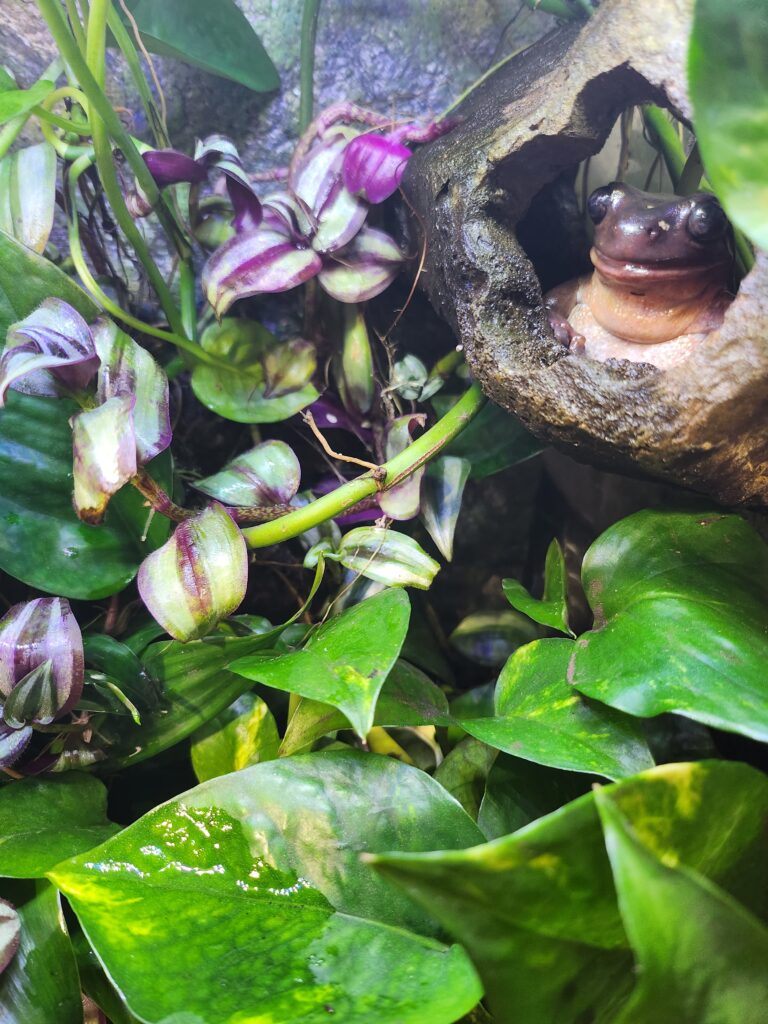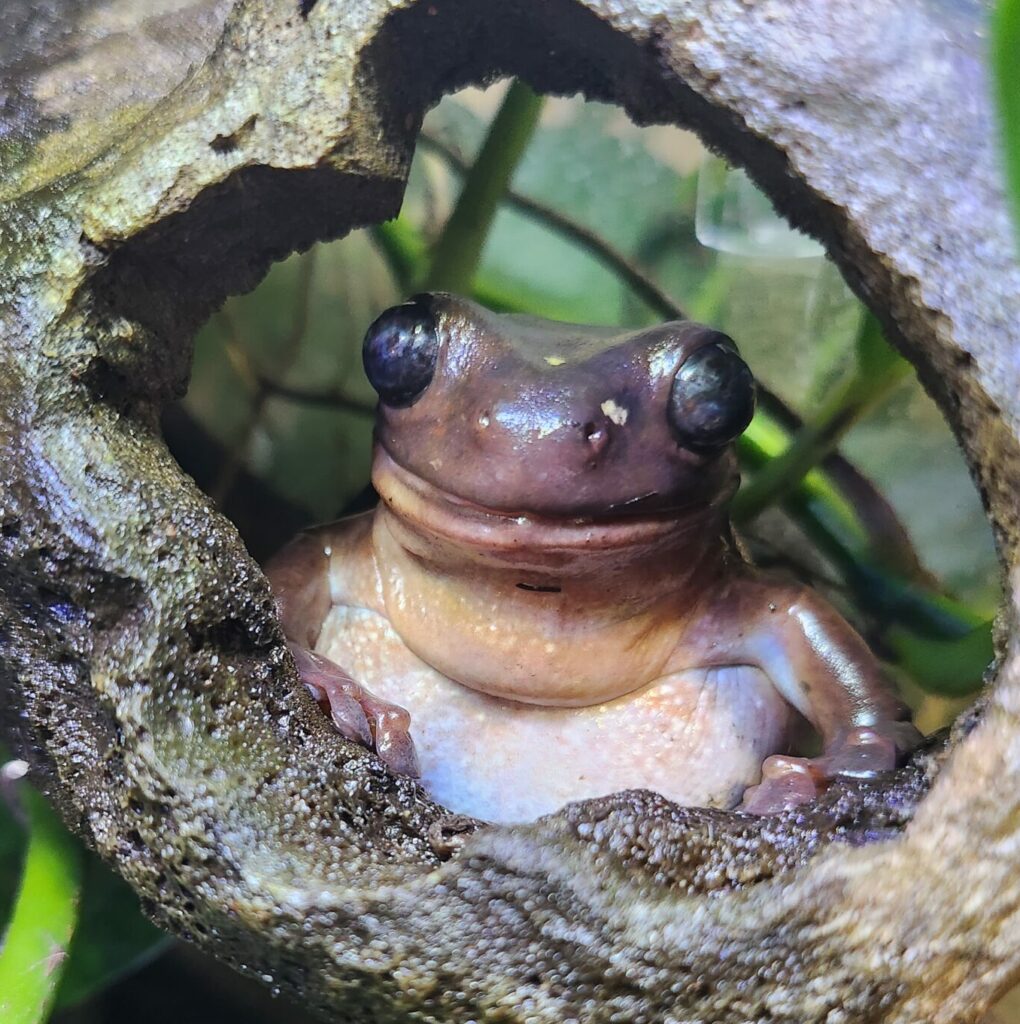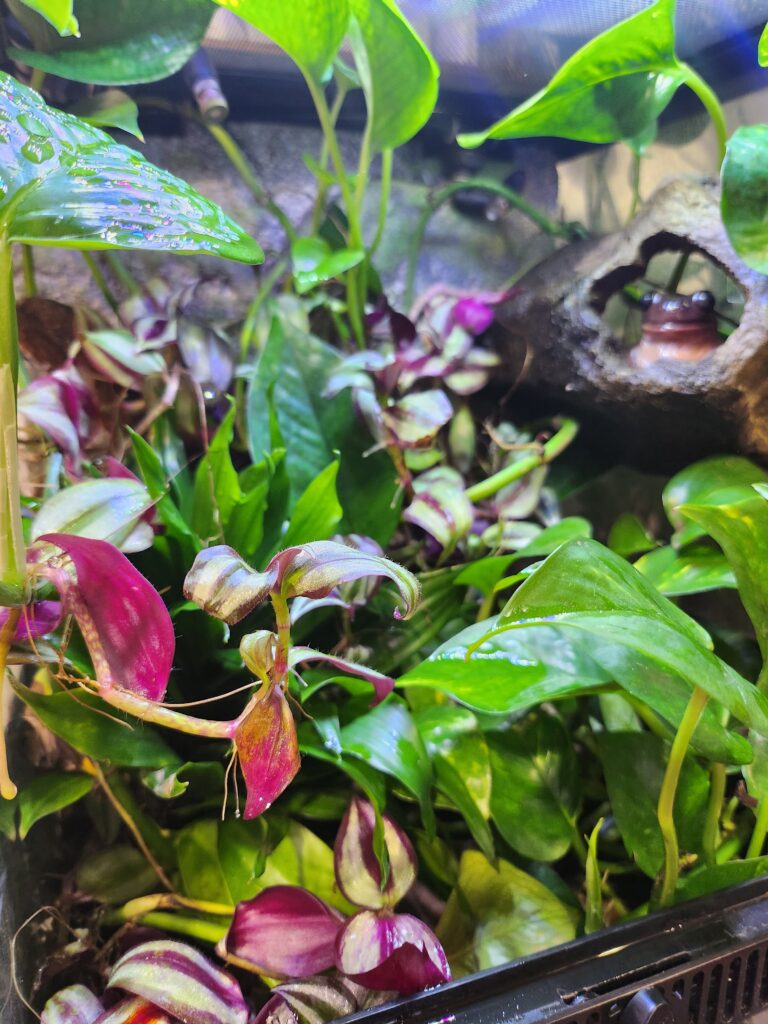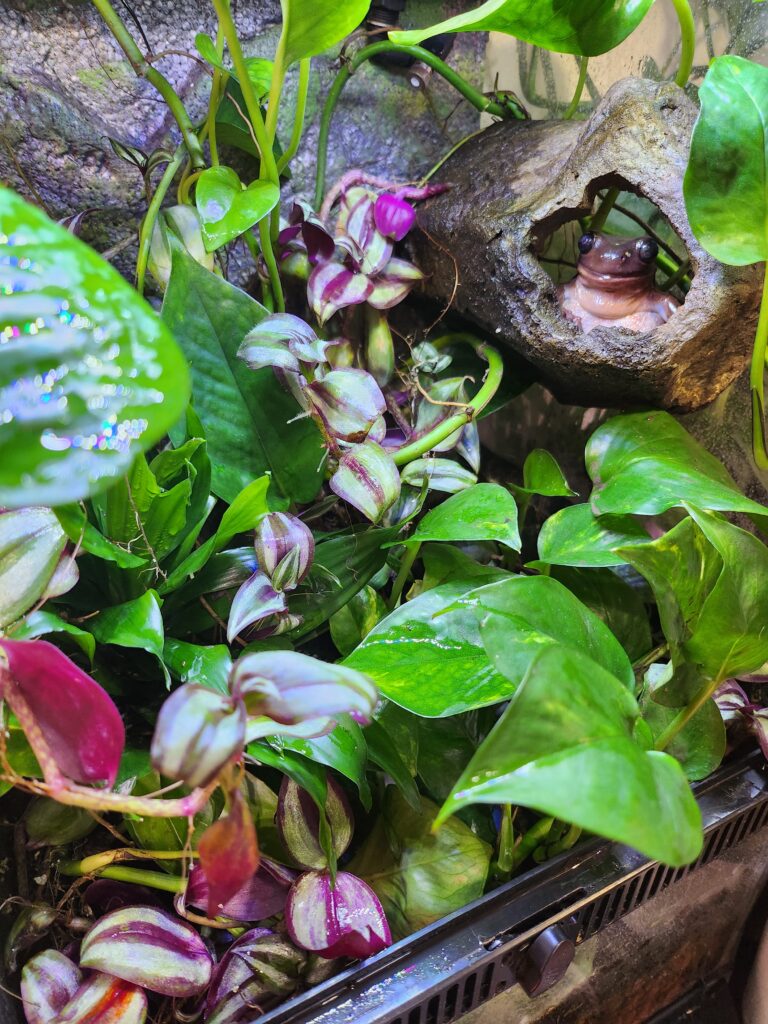My White’s Tree Frog (or dumpy tree frog in some circles) is happy and thriving in his bioactive setup. I adopted him from a zoo that had to rehome some animals during COVID, and he’s been with me ever since. He’s been in his current setup for over a year and loves it.
I have him in a fully bioactive setup. So, what is a bioactive setup? I have a whole post about the basics, but the key takeaway is the terrarium itself is (mostly) self-sustaining. I almost never cleaned his tank besides spot cleaning and glass cleaning. Sometimes, I trim the plants when they become overgrown, but that’s about it. It’s astonishingly low maintenance.

What is a White’s Tree Frog?
White’s frogs are large for a frog, around 3-5in. They are handleable, but I avoid handling mine if possible. Unfortunately, my frog, Tarzan, is around 10-12 years old and either mostly or entirely blind. He is still happy as can be and loves to eat constantly.
These are generally considered beginner frogs; they are pretty hardy and can live up to 20 years old. They are native to Australia and are tropical frogs. They are almost exclusively captive breeds due to Australian laws on exporting native animals.
Color
These frogs come in many different colors, from blue to green, sometimes gray, and they do change slightly colors sometimes. Tarzan is a nice muddy brown color with a lighter underside, and a few fat deposits on his face and back. Suffice it to say, he was not the color I would have picked, but he needed a home so now I have a brown frog.
They are sometimes called Dumpy frogs due to their derby face and reputation as voracious eaters. The picture below clearly illistrates said derby face.

Tarzan is showing off his lovely brown complexion and derby face, with some yellow/white fat deposit spots
Terrarium Size
I have him in a 12x12x18 Zilla terrarium that I got on amazon. Since he is a tree frog, vertical space is a must. This tank is a little small for a White’s frog, but given that Tarzan can’t see well, he seems to like a smaller area. He had a more extensive setup before but seems happier with less space to get lost.
Humidity
This cannot be underestimated due to its bioactivity and because these frogs need high humidity. I’ve tried accomplishing this in a few ways: misting manually, a fogger, and now an in-tank rain simulator. It was a cheap $30 find on Amazon that was worth every penny. Simple to set up, I can adjust the flow, the duration, and the frequency. I can’t say enough positive things about it; I love it, and so does Tarzan.
I also keep a water bowl for him to sit in; he loves to sit in his water bowl and always has. Just make sure to use distilled water for the humidifier, but not for the water bowl; just use dechlorinated water in the bowl.
Feedings
This is probably my least favorite part of caring for Tarzan; he needs live food. I do crickets occasionally, but since he’s blind, he misses them most of the time. Then I just have crickets lose in his terrarium, or, worse, my house. I primarily feed him worms; they are easy to access, live for months in my fridge, and aren’t messy. He loves his worms; I feed him every 1-4 days, and he is always ready to eat.
Let’s talk about calcium. All amphibians need it, and White’s are no exception. They should have dusted insects around once a week, more when younger. There are a lot of different types of calcium supplements. I grabbed one sale at my local pet store, which lasted a long time.
Light
I have him on a 12-hour day-night light schedule; he has an LED light due to the live plants in his tank. I got it off Amazon for around $10, and it’s an excellent light for plants. Since White’s frogs are nocturnal, they do not need UVB. It won’t hurt them, but it’s not required and can be expensive; just a regular LED light works fine for Tarzan.

Heat
Given these are tropical frogs, they like it hot. Similar to the humidity, I’ve tried a few ways to achieve the needed temperatures. I’ve tried a heat lamp, but it made one spot far too warm; ceramic bulbs had the same effect. He has three heating pads covering the bottom and two sides of his tank. His temperature fluctuates from 70 to 86, depending on the time of day and area of the tank. Generally, having a warmer area, the bottom in his terrarium, and a cooler area is an ideal; that way, he can choose which one he wants at any given time.
Pro tip: get one of those laser tempature guns off Amazon, they are so easy to use and are very helpful, especially when first setting up the terrarium.
Costs
White’s frogs themselves are not overly expensive, especially if you can find one that needs a new home like I did. The terrarium alone is around $100, the heating pads are $45 for all three, and the humidifier is $30. Then, add substrate, a hide, water bowl, light, live plants, and the bioactive cleanup crew. It can get expensive. Luckily, it’s very low cost once the startup costs are done. I just pay the electricity to run his lights and heating pads, and his food is cheap; worms and crickets cost pennies.
Is a White’s Frog the Frog For You?
If you’re looking for a frog that is large enough to see, able to be handled minimally, and relativity active based on frog standards, then yes, a White’s frog could be for you. The startup costs are similar to those of all reptiles/amphibians. Their care is easy for a frog; they live for a long time and are generally hardy. Overall, they have a lot of personality for a frog; I strongly recommend them to people who love frogs and want an entry-level frog that isn’t overly complex to care for.
Plus, they are objectivly adorable

